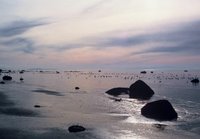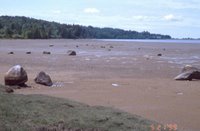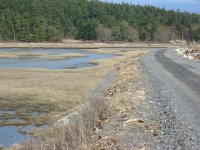

Nice little park at the mouth of a small stream valley on the west side of the Tacoma Narrows. Great place to watch the new bridge being built. Less than two years ago the large rock bulkhead to the north was removed and replaced with a row of logs. The logs are securely anchored with large chains attached to steel posts. The logs are all the same size, the same distance apart, and oriented in the same direction. Very tidy -- probably just like the plans showed (bottom picture, last year). But nature is already rearranging the site, leaving some of the logs in awkward positions (top picture, taken this morning).
The goal was a softer, more natural shoreline. The result is a lesson about beaches. The removal of the rock bulkhead along with some of the old fill was a big step in the right direction, but the placement of the anchored logs was a small step backwards. The beach is seeking a more stable configuration and the logs have little influence on it's desire to do this. They will simply look more and more out of place as the beach profile adjusts. It's not that logs aren't an important component of Puget Sound beaches, nor that logs might help mitigate erosion in some situations. It's just that there are more significant things affecting this beach. The bank is old fill that probably extends seaward of the original shoreline. In addition, the curious concrete stream outfall structure acts like a groin to northward drift, exacerbating erosion just to the north.
There are probably some great solutions to this site, but they'll require some money, some excavation, and some geologic understanding. If it's done right, the stream will be set free and the logs will show up on their own.


















